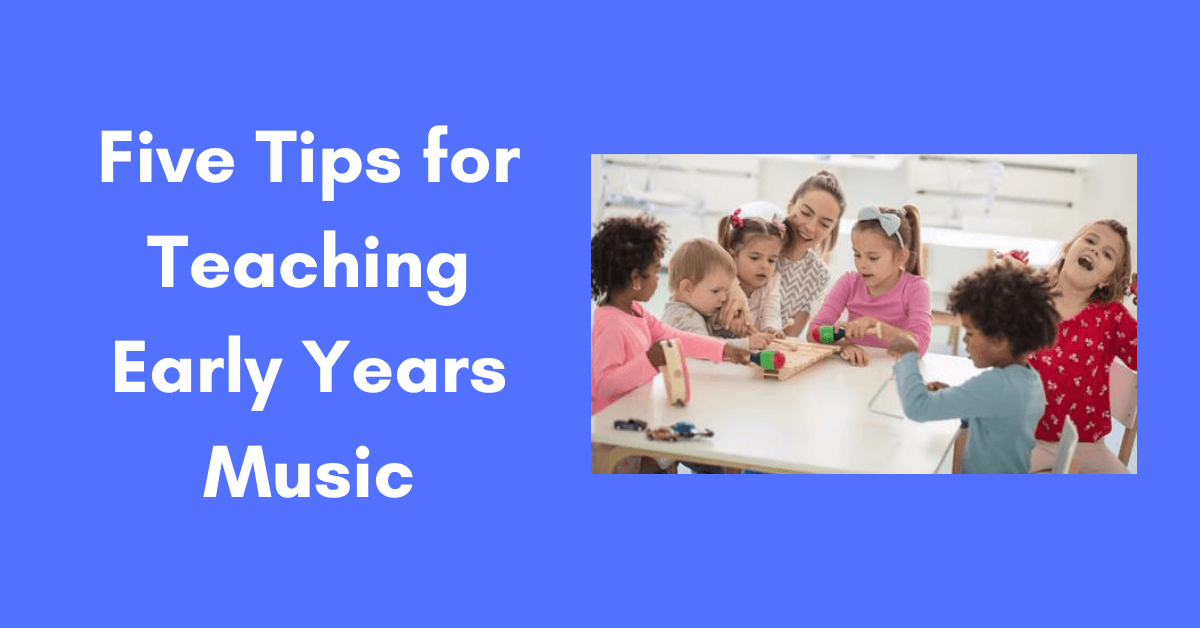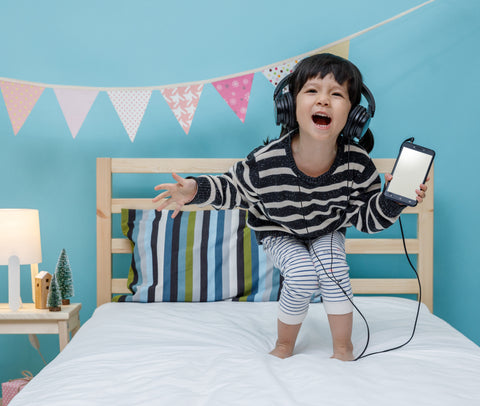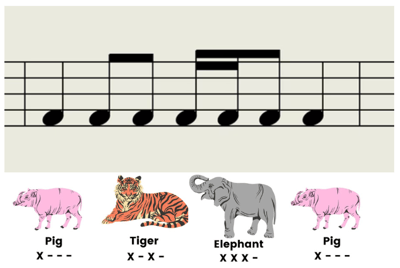Five Tips for Teaching Early Years Music
August 4th, 2023
4 min read

Nobody loves music like children love music. Many of us are starting to dance and move to a beat before we can even talk!
So why, for many teachers, is it such a daunting task to think about music in a classroom setting?
If the words ‘musical education’ conjure up images of crazy dotted pages and J.K. Simmons from Whiplash, you are certainly not alone.
But the truth is that music already underlies so much of early years education: from the exaggerated pitches of our ‘baby voice’ (now officially encouraged in the new EYFS guidelines in the UK) to the rhymes and games we use to teach language and numeracy.
However, despite this proximity to music in everyday teaching life, when it comes to teaching the music itself - notes, rhythm, harmony - many non-specialist educators find themselves at a loss.
This blog will give you five top tips for teaching early years music, and help show you that you don’t have to be Mozart to help kids in the first few steps of their musical journey.

1. Learning to listen
Our first tip is to try and reimagine music education as teaching someone how to listen, explore, and understand sound, as opposed to focusing solely on how to read/perform sheet music.
Music can be approached in a similar way to how we might develop language and communication skills, such as:
- Repeating sounds to help children internalise them (perhaps by clapping rhythms in a call-and-response format)
- Asking questions about how different sounds make the children feel and describing them with the spoken language they are developing in tandem
- Encouraging children to try out this new musical vocabulary for themselves.
- Does this instrument/object make a warm sound; a cold sound; a hard sound; a soft sound?
It’s easy to forget, with so many amazing performers in the world, that being a good listener is also a key part of musicianship, and that this is still a useful skill even for those who don’t go on to pursue a music career. A good music education teaches that meaning can be communicated with sounds beyond the spoken word, and equip children with a means to express themselves in this way.
2. Inspire an eclectic musical taste
Our second tip is not to underestimate what kids can enjoy listening to!
Nursery rhymes and simple tunes are great for getting kids started with following along to melodies, and they undoubtedly belong in a preschool music classroom. However, if you’re putting on some background music, or having a dance party, don’t be afraid to be more experimental than simply typing ‘music for kids’ into YouTube. The sounds we are exposed to inform our creativity and inspire us to keep learning, and our capacity for absorbing new sounds is a skill we are developing from birth.

And as a quick side note, don’t be bought over by the Mozart Effect - a hangover from a study in the 1990s that suggested playing children classical music develops them into some kind of ‘musical genius’.
It has been proven that all music is equally stimulating and has similar positive effects on the brain, so spin some Stevie Wonder or play some Prince so they can dance around to whatever music engages them! Keep it colourful, keep it energetic, and be responsive to what music your class enjoys.
3. Reading music
Our third tip is to introduce music with terms and imagery that children already understand.
A common mistake many educators make when introducing music is to jump straight into using Western classical music notation. Not only is this form becoming less and less relevant in the modern music industry, but the abstract relationship between the symbols and the notes is not intuitive for a young child.
Consider instead using words the children are familiar with to visualise rhythms and use their syllables to create different patterns.
In this example from a Soundbops educational resource, animal names and pictures are used to visualise notation. Compare the following images and consider which is more legible to someone not already versed in music theory.

The same goes for melody and pitched sheet music; the more senses and extra-musical information you can utilise will only help reinforce the connection between the symbols and what they mean. For instance, labelling notes with colours is a much more direct visual prompt for children to follow than reading a dot’s position on a grid.
4. There are no wrong notes!
A lot of the inhibitions we form around teaching music stem from a broader cultural perception of what good musicianship is and the fear of looking foolish when we inevitably get things wrong, so our fourth tip is to make mistakes...and to let your class see (and hear!) them.
The problem with reading music from a page is that it sets us up to believe there is a right and a wrong way to make music.
Of course, if you play a dud note in the middle of Three Blind Mice everyone will know it's not meant to be there. But if you can learn to laugh and start again from a few notes before - playing through a section slowly and methodically - you’re setting a far more realistic example of what music practice looks like. Human beings aren’t jukeboxes and every performance is going to have its quirks and differences, no matter how practiced you are.
If you can instil this in your class, they will have a far more comfortable time playing together and exploring music without fearing they’ll get it wrong - an experience that resonates with a lot of adults today. Treat a child’s musical mistakes as you would a mispronunciation, where we don’t want to jump in and correct them, but rather guide them. Repeat the phrase yourself and ask if they can hear the difference (and what needs to change so that they sound the same).
5. The right time to start playing an instrument
Our last tip for teaching early years music is not to rush toward traditional instruments.
Learning on a piano or a guitar can be limiting at a young age because these instruments are designed for adult hands and bodies. The fine motor skills and dexterity required to play concepts like chords and scales develop slowly, and simply scaling instruments down to have smaller keys or a half-size fretboard is inadequate in dealing with these issues.
You’re never too young to start learning, provided you keep the instruments simple and stay away from the ones that require fiddly hand shapes and stronger finger muscles. Xylophones, glockenspiels, and auxiliary percussion instruments like shakers and bells are all great alternatives, but the sound of a dozen tambourines can get very grating very quickly and turn music time into a thing of dread. So what can be done?
Well, Soundbops has been designed with these physical limitations in mind and allows kids to stack notes on top of one another (building chords) and play them with a single button.
This way they can develop an understanding of music and become more comfortable with musical concepts, long before they are ready to graduate to a traditional instrument. Each Soundbops also comes with a selection of 10 instrument voices, and - mercifully - a headphone port, for when you’re all music-ed out but the kids aren't.

Hopefully, this has been a helpful guide for introducing music to your early years class!
For more information and resources for early years music and the best way to inspire kids on their musical journey, check out Soundbops.
Adam is the Content Manager at pBone Music. This should mean that he’s the ideal person to write about himself, but he finds boasting in the third person a little awkward. He honed his word wizardry with a degree in English Language and Literature at the University of Leeds. He has since written copy for clients and businesses across the land, from awards to something beginning with “z”. He also spent a number of years as a musician. He has written pop songs and even jingles for kids, performed more first dances at weddings than you could shake a pBuzz at, and once played a gig for a pie company at The Etihad Stadium in Manchester. When he’s not reminiscing about those good old days, you might find Adam enjoying the football (although as an Everton fan, that can be difficult). He also loves spending time with his partner, Jen, and his family and friends, and sincerely hopes they feel the same way.
Topics: